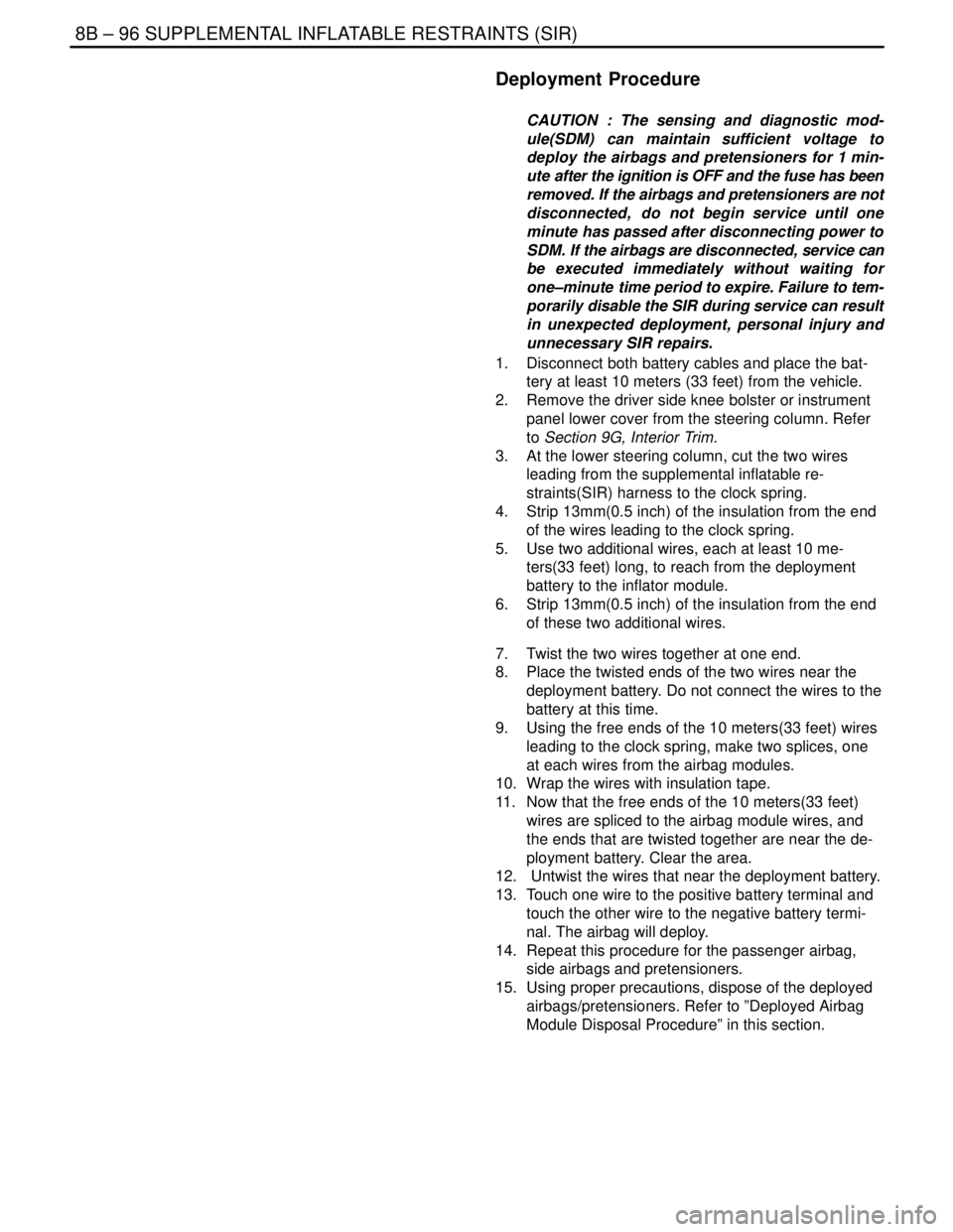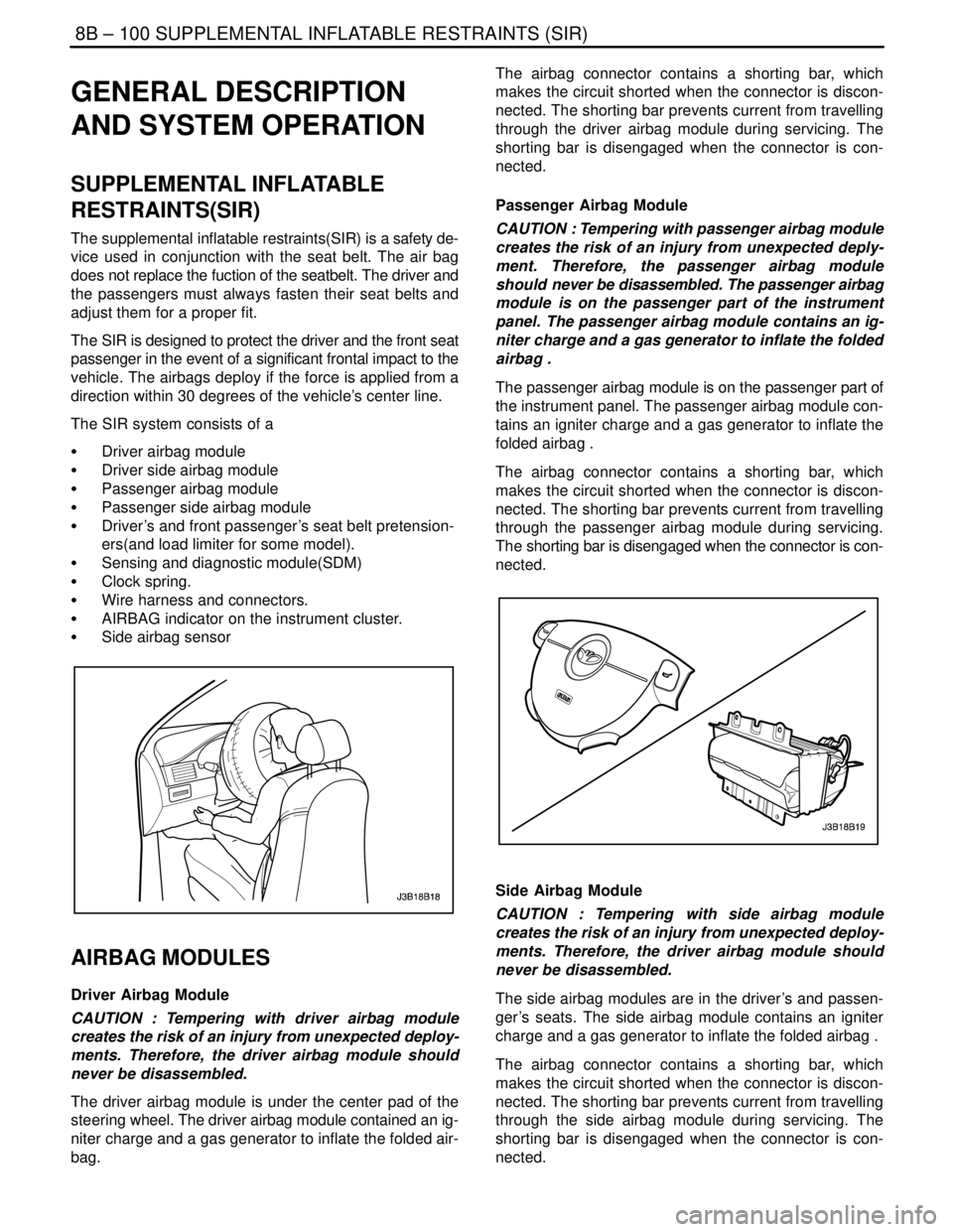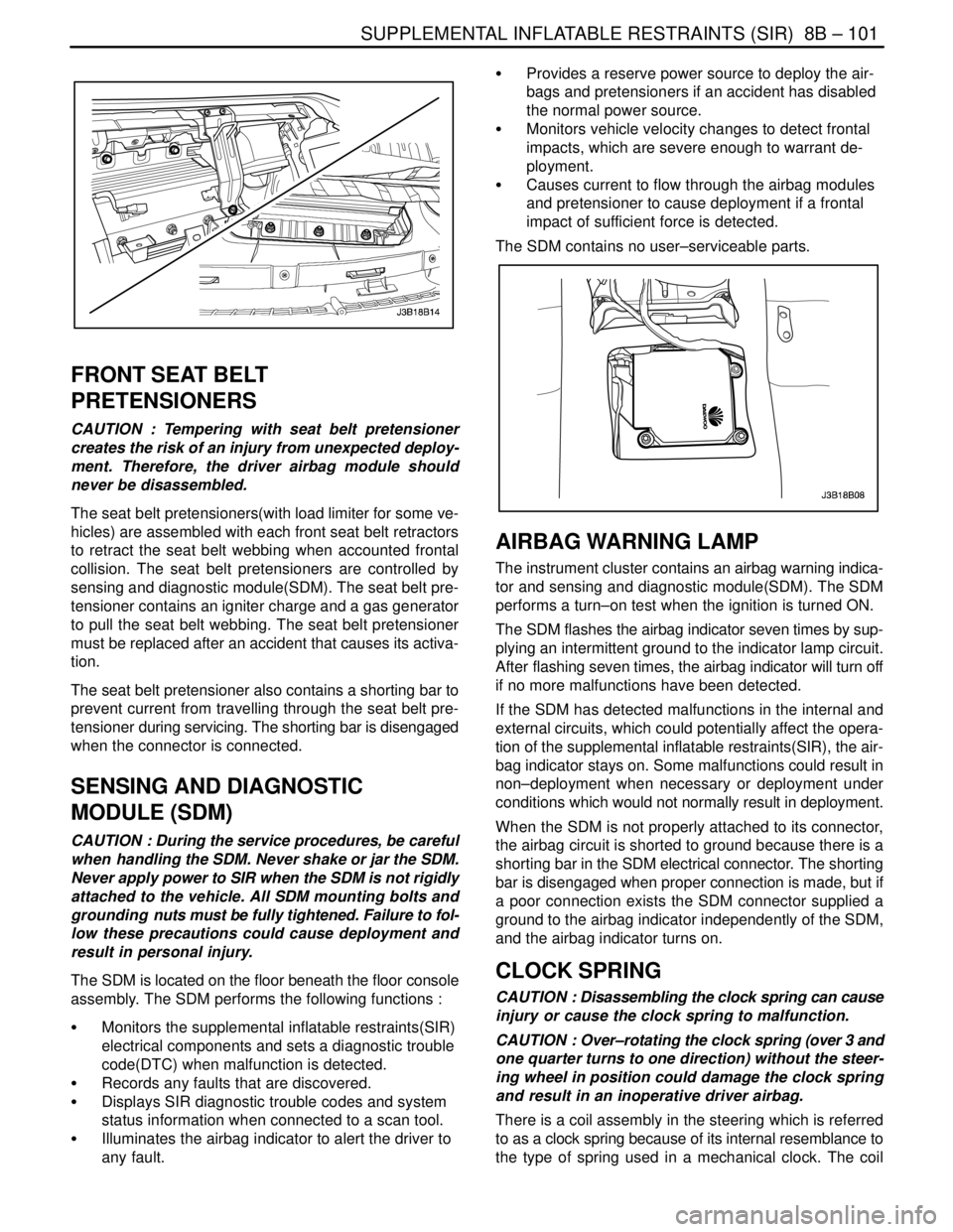2004 DAEWOO LACETTI clock
[x] Cancel search: clockPage 2200 of 2643

8B – 96ISUPPLEMENTAL INFLATABLE RESTRAINTS (SIR)
DAEWOO V–121 BL4
Deployment Procedure
CAUTION : The sensing and diagnostic mod-
ule(SDM) can maintain sufficient voltage to
deploy the airbags and pretensioners for 1 min-
ute after the ignition is OFF and the fuse has been
removed. If the airbags and pretensioners are not
disconnected, do not begin service until one
minute has passed after disconnecting power to
SDM. If the airbags are disconnected, service can
be executed immediately without waiting for
one–minute time period to expire. Failure to tem-
porarily disable the SIR during service can result
in unexpected deployment, personal injury and
unnecessary SIR repairs.
1. Disconnect both battery cables and place the bat-
tery at least 10 meters (33 feet) from the vehicle.
2. Remove the driver side knee bolster or instrument
panel lower cover from the steering column. Refer
to Section 9G, Interior Trim.
3. At the lower steering column, cut the two wires
leading from the supplemental inflatable re-
straints(SIR) harness to the clock spring.
4. Strip 13mm(0.5 inch) of the insulation from the end
of the wires leading to the clock spring.
5. Use two additional wires, each at least 10 me-
ters(33 feet) long, to reach from the deployment
battery to the inflator module.
6. Strip 13mm(0.5 inch) of the insulation from the end
of these two additional wires.
7. Twist the two wires together at one end.
8. Place the twisted ends of the two wires near the
deployment battery. Do not connect the wires to the
battery at this time.
9. Using the free ends of the 10 meters(33 feet) wires
leading to the clock spring, make two splices, one
at each wires from the airbag modules.
10. Wrap the wires with insulation tape.
11. Now that the free ends of the 10 meters(33 feet)
wires are spliced to the airbag module wires, and
the ends that are twisted together are near the de-
ployment battery. Clear the area.
12. Untwist the wires that near the deployment battery.
13. Touch one wire to the positive battery terminal and
touch the other wire to the negative battery termi-
nal. The airbag will deploy.
14. Repeat this procedure for the passenger airbag,
side airbags and pretensioners.
15. Using proper precautions, dispose of the deployed
airbags/pretensioners. Refer to ”Deployed Airbag
Module Disposal Procedure” in this section.
Page 2204 of 2643

8B – 100ISUPPLEMENTAL INFLATABLE RESTRAINTS (SIR)
DAEWOO V–121 BL4
GENERAL DESCRIPTION
AND SYSTEM OPERATION
SUPPLEMENTAL INFLATABLE
RESTRAINTS(SIR)
The supplemental inflatable restraints(SIR) is a safety de-
vice used in conjunction with the seat belt. The air bag
does not replace the fuction of the seatbelt. The driver and
the passengers must always fasten their seat belts and
adjust them for a proper fit.
The SIR is designed to protect the driver and the front seat
passenger in the event of a significant frontal impact to the
vehicle. The airbags deploy if the force is applied from a
direction within 30 degrees of the vehicle’s center line.
The SIR system consists of a
S Driver airbag module
S Driver side airbag module
S Passenger airbag module
S Passenger side airbag module
S Driver’s and front passenger’s seat belt pretension-
ers(and load limiter for some model).
S Sensing and diagnostic module(SDM)
S Clock spring.
S Wire harness and connectors.
S AIRBAG indicator on the instrument cluster.
S Side airbag sensor
AIRBAG MODULES
Driver Airbag Module
CAUTION : Tempering with driver airbag module
creates the risk of an injury from unexpected deploy-
ments. Therefore, the driver airbag module should
never be disassembled.
The driver airbag module is under the center pad of the
steering wheel. The driver airbag module contained an ig-
niter charge and a gas generator to inflate the folded air-
bag.The airbag connector contains a shorting bar, which
makes the circuit shorted when the connector is discon-
nected. The shorting bar prevents current from travelling
through the driver airbag module during servicing. The
shorting bar is disengaged when the connector is con-
nected.
Passenger Airbag Module
CAUTION : Tempering with passenger airbag module
creates the risk of an injury from unexpected deply-
ment. Therefore, the passenger airbag module
should never be disassembled. The passenger airbag
module is on the passenger part of the instrument
panel. The passenger airbag module contains an ig-
niter charge and a gas generator to inflate the folded
airbag .
The passenger airbag module is on the passenger part of
the instrument panel. The passenger airbag module con-
tains an igniter charge and a gas generator to inflate the
folded airbag .
The airbag connector contains a shorting bar, which
makes the circuit shorted when the connector is discon-
nected. The shorting bar prevents current from travelling
through the passenger airbag module during servicing.
The shorting bar is disengaged when the connector is con-
nected.
Side Airbag Module
CAUTION : Tempering with side airbag module
creates the risk of an injury from unexpected deploy-
ments. Therefore, the driver airbag module should
never be disassembled.
The side airbag modules are in the driver’s and passen-
ger’s seats. The side airbag module contains an igniter
charge and a gas generator to inflate the folded airbag .
The airbag connector contains a shorting bar, which
makes the circuit shorted when the connector is discon-
nected. The shorting bar prevents current from travelling
through the side airbag module during servicing. The
shorting bar is disengaged when the connector is con-
nected.
Page 2205 of 2643

SUPPLEMENTAL INFLATABLE RESTRAINTS (SIR) 8B – 101
DAEWOO V–121 BL4
FRONT SEAT BELT
PRETENSIONERS
CAUTION : Tempering with seat belt pretensioner
creates the risk of an injury from unexpected deploy-
ment. Therefore, the driver airbag module should
never be disassembled.
The seat belt pretensioners(with load limiter for some ve-
hicles) are assembled with each front seat belt retractors
to retract the seat belt webbing when accounted frontal
collision. The seat belt pretensioners are controlled by
sensing and diagnostic module(SDM). The seat belt pre-
tensioner contains an igniter charge and a gas generator
to pull the seat belt webbing. The seat belt pretensioner
must be replaced after an accident that causes its activa-
tion.
The seat belt pretensioner also contains a shorting bar to
prevent current from travelling through the seat belt pre-
tensioner during servicing. The shorting bar is disengaged
when the connector is connected.
SENSING AND DIAGNOSTIC
MODULE (SDM)
CAUTION : During the service procedures, be careful
when handling the SDM. Never shake or jar the SDM.
Never apply power to SIR when the SDM is not rigidly
attached to the vehicle. All SDM mounting bolts and
grounding nuts must be fully tightened. Failure to fol-
low these precautions could cause deployment and
result in personal injury.
The SDM is located on the floor beneath the floor console
assembly. The SDM performs the following functions :
S Monitors the supplemental inflatable restraints(SIR)
electrical components and sets a diagnostic trouble
code(DTC) when malfunction is detected.
S Records any faults that are discovered.
S Displays SIR diagnostic trouble codes and system
status information when connected to a scan tool.
S Illuminates the airbag indicator to alert the driver to
any fault.S Provides a reserve power source to deploy the air-
bags and pretensioners if an accident has disabled
the normal power source.
S Monitors vehicle velocity changes to detect frontal
impacts, which are severe enough to warrant de-
ployment.
S Causes current to flow through the airbag modules
and pretensioner to cause deployment if a frontal
impact of sufficient force is detected.
The SDM contains no user–serviceable parts.
AIRBAG WARNING LAMP
The instrument cluster contains an airbag warning indica-
tor and sensing and diagnostic module(SDM). The SDM
performs a turn–on test when the ignition is turned ON.
The SDM flashes the airbag indicator seven times by sup-
plying an intermittent ground to the indicator lamp circuit.
After flashing seven times, the airbag indicator will turn off
if no more malfunctions have been detected.
If the SDM has detected malfunctions in the internal and
external circuits, which could potentially affect the opera-
tion of the supplemental inflatable restraints(SIR), the air-
bag indicator stays on. Some malfunctions could result in
non–deployment when necessary or deployment under
conditions which would not normally result in deployment.
When the SDM is not properly attached to its connector,
the airbag circuit is shorted to ground because there is a
shorting bar in the SDM electrical connector. The shorting
bar is disengaged when proper connection is made, but if
a poor connection exists the SDM connector supplied a
ground to the airbag indicator independently of the SDM,
and the airbag indicator turns on.
CLOCK SPRING
CAUTION : Disassembling the clock spring can cause
injury or cause the clock spring to malfunction.
CAUTION : Over–rotating the clock spring (over 3 and
one quarter turns to one direction) without the steer-
ing wheel in position could damage the clock spring
and result in an inoperative driver airbag.
There is a coil assembly in the steering which is referred
to as a clock spring because of its internal resemblance to
the type of spring used in a mechanical clock. The coil
Page 2206 of 2643

8B – 102ISUPPLEMENTAL INFLATABLE RESTRAINTS (SIR)
DAEWOO V–121 BL4
spring should never be disassembled, and there is no
timekeeping function. The clock spring contains two or
three current–carrying coils. One of the current–carrying
coils maintains continuous contact within the driver de-
ployment loop while the steering wheel is rotated. The
clock spring also contains coils that maintain continuous
contact for horn and remote audio control switch circuit.
Turning the steering wheel in one direction tightens the
coil, and turning the steering wheel in the opposite direc-
tion loosens the coil. Do not turn the clock spring when the
steering wheel is not attached. Refer to ”Clock Spring” in
this section for proper installation of the clock spring.
The clock spring also includes the wiring and the connec-
tors for the horn circuit and the driver airbag circuit. A yel-
low two–way connector on the lower steering column is at-
tached to the clock spring wiring. The yellow connector to
the airbag contains a shorting bar which connects the driv-
er high circuit to driver low circuit when the connector is
disconnected.
The shorting bar prevents current from travelling through
the driver airbag module during servicing. The shorting bar
is disengaged when the clock spring connector is con-
nected.WIRING HARNESS CONNECTORS
If the sensing and diagnostic module (SDM) electrical con-
nector is not attached properly, a built in shorting bar will
connect the wire from airbag warning lamp with the SDM
ground wire. This turns on the airbag indicator . To prevent
deployment during servicing, additional shorting bars are
located in following locations :
S The clock spring electrical connector at the lower
steering column.
S The passenger airbag module.
S The driver airbag module.
S The seat belt pretensioners.
The shorting bar is only a backup safety device. Always
disable the supplemental inflatable restraints(SIR) before
beginning any service procedure.
Page 2220 of 2643

9A – 14IBODY WIRING SYSTEM
DAEWOO V–121 BL4
I/P Fuse Block
FuseRating/SourceCircuit
F110AIGN 1SDM
F210AIGN 1TCM, ECM, Generator, VGIS, VSS
F315AIGN 1Hazard Switch
F410AIGN 1Cluster, DRL Module, Chime Bell, Brake Switch,
SSPS Module, A/C Control Switch
F5–Spare–
F610AIGN 2A/C Comp. Relay, Defog Relay, Power Window
Relay, Head Lamp Relay
F720AIGN 2Blower Relay, A/C Control Switch, FATC
F815AIGN 2Electric Mirror Switch, Folding Mirror, Sun Roof
Module
F925AIGN 1Wiper Motor, Wiper Switch
F10–Spare–
F1110AIGN 1EBCM, Oil Feeding Connector
F1210AIGN 1Immobilizer, Anti Theft Control Unit, Rain Sensor
Unit
F1310AB+TCM
F1415AB+Hazard Switch
F1515AB+Anti Theft Control Unit
F1610AB+DLC
F1710AACCAudio, Clock
F1815AACCExtra Power Jack
F1915AACCCigar Lighter
F2010AIGN 1Reverse Lamp Switch, PNP Switch
F2115AB+Rear Fog Relay
F2215AB+Clock, FATC, A/C Control Switch
F2315AB+Audio
F2410AB+Immobilizer
Page 2300 of 2643

SECTION : 9E
INSTRUMENTATION/DRIVER INFORMATION
CAUTION : Disconnect the negative battery cable before removing or installing any electrical unit or when a tool
or equipment could easily come in contact with exposed electrical terminals. Disconnecting this cable will help
prevent personal injury and damage to the vehicle. The ignition must also be in LOCK unless otherwise noted.
TABLE OF CONTENTS
SPECIFICATIONS9E–2 . . . . . . . . . . . . . . . . . . . . . . . . . .
Fastener Tightening Specifications 9E–2. . . . . . . . . . .
Instrument Cluster Indicator Lamps
Specifications 9E–2. . . . . . . . . . . . . . . . . . . . . . . . . . .
SCHEMATIC AND ROUTING DIAGRAMS9E–3 . . . . .
Instrument Cluster Circuit (1 of 2) 9E–3. . . . . . . . . . . .
Instrument Cluster Circuit (2 of 2) 9E–4. . . . . . . . . . . .
Cigar Lighter And Extra Power Jack Circuit 9E–5. . . .
DIAGNOSIS9E–6 . . . . . . . . . . . . . . . . . . . . . . . . . . . . . . . .
Cigar Lighter 9E–6. . . . . . . . . . . . . . . . . . . . . . . . . . . . . .
Digital Clock 9E–7. . . . . . . . . . . . . . . . . . . . . . . . . . . . . .
Instrument Panel Illumination 9E–9. . . . . . . . . . . . . . . .
Speedometer 9E–10. . . . . . . . . . . . . . . . . . . . . . . . . . . .
Fuel Gauge 9E–10. . . . . . . . . . . . . . . . . . . . . . . . . . . . . .
Temperature Gauge 9E–11. . . . . . . . . . . . . . . . . . . . . . .
Instrument Cluster Indicator Lamps 9E–12. . . . . . . . .
Chime Module 9E–13. . . . . . . . . . . . . . . . . . . . . . . . . . . .
Chime Module 9E–14. . . . . . . . . . . . . . . . . . . . . . . . . . . .
MAINTENANCE AND REPAIR9E–18 . . . . . . . . . . . . . .
ON–VEHICLE SERVICE 9E–18. . . . . . . . . . . . . . . . . . . .
Center Molding 9E–18. . . . . . . . . . . . . . . . . . . . . . . . . . .
Instrument Cluster Trim Panel 9E–18. . . . . . . . . . . . . .
Garnish Molding 9E–19. . . . . . . . . . . . . . . . . . . . . . . . . .
Ashtray 9E–19. . . . . . . . . . . . . . . . . . . . . . . . . . . . . . . . . . Cigar Lighter 9E–20. . . . . . . . . . . . . . . . . . . . . . . . . . . . .
Glove Box 9E–20. . . . . . . . . . . . . . . . . . . . . . . . . . . . . . .
Notchback Deposit Box 9E–21. . . . . . . . . . . . . . . . . . . .
Notchback Digital Clock 9E–21. . . . . . . . . . . . . . . . . . .
Hatchback Digital Clock 9E–22. . . . . . . . . . . . . . . . . . .
Instrument Cluster 9E–23. . . . . . . . . . . . . . . . . . . . . . . .
Instrument Cluster Dimmer/Headlamp
Leveling Switch 9E–23. . . . . . . . . . . . . . . . . . . . . . . . .
Instrument Cluster Indicator Lamps 9E–24. . . . . . . . .
Instrument Panel 9E–24. . . . . . . . . . . . . . . . . . . . . . . . .
Chime Module 9E–28. . . . . . . . . . . . . . . . . . . . . . . . . . . .
GENERAL DESCRIPTION AND SYSTEM
OPERATION9E–30 . . . . . . . . . . . . . . . . . . . . . . . . . . . . .
Cigar Lighter 9E–30. . . . . . . . . . . . . . . . . . . . . . . . . . . . .
Ashtray 9E–30. . . . . . . . . . . . . . . . . . . . . . . . . . . . . . . . . .
Instrument Panel Vents 9E–30. . . . . . . . . . . . . . . . . . . .
Glove Box 9E–30. . . . . . . . . . . . . . . . . . . . . . . . . . . . . . .
Digital Clock 9E–30. . . . . . . . . . . . . . . . . . . . . . . . . . . . .
Instrument Cluster 9E–30. . . . . . . . . . . . . . . . . . . . . . . .
Speedometer/Odometer/Trip Odometer 9E–30. . . . . .
Fuel Gauge 9E–30. . . . . . . . . . . . . . . . . . . . . . . . . . . . . .
Temperature Gauge 9E–30. . . . . . . . . . . . . . . . . . . . . . .
Instrument Cluster Indicator Lamps 9E–30. . . . . . . . .
Chime Module 9E–30. . . . . . . . . . . . . . . . . . . . . . . . . . . .
Page 2301 of 2643

9E – 2IINSTRUMENTATION/DRIVER INFORMATION
DAEWOO V–121 BL4
SPECIFICATIONS
FASTENER TIGHTENING SPECIFICATIONS
ApplicationNSmLb–FtLb–In
Air Deflector Screws2–18
Chime Module Screws4–35
Clock Screws2–18
Cupholder Screws2.5–22
Deposit Box Screws2.5–22
Driver Knee Bolster Bolts10–89
Floor Console Brace Bolts4–35
Floor Console Brace Nuts4–35
HVAC Controls Screws4–35
Instrument Cluster Screws4–35
Instrument Cluster Trim Panel Screws4–35
Instrument Panel End Bolts2015–
Instrument Panel End Screws4–35
Instrument Panel Nuts Above the Steering Column2015–
Instrument Panel Bolts Behind the HVAC Controls4–35
Steering Column Bracket Nut2216–
Steering Column Lower Trim Cover Screws2.5–22
Steering Column U–Clamp Nuts2216–
Steering Column Upper Trim Cover Screws3–27
INSTRUMENT CLUSTER INDICATOR LAMPS
SPECIFICATIONS
Indicator LampColorBulb
ABS WarningAmber14 v 1.4 W
Airbag WarningRed14 v 1.4 W
Battery Charge IndicatorRed14 v 1.4 W
Check EngineAmber14 v 1.4 W
Door Open WarningRed14 v 1.4 W
Engine OverheatRed14 v 1.4 W
Fasten Seat Belt WarningRed14 v 1.4 W
High Beam IndicatorBlue14 v 1.4 W
Low Fuel Level WarningAmber14 v 4 W
Oil Pressure WarningRed14 v 1.4 W
Parking Brake Indicator and Brake Fluid WarningRed14 v 1.4 W
Service Engine Soon WarningAmber14 v 1.4 W
Transaxle Power Mode IndicatorAmber14 v 1.4 W
Turn Signal IndicatorsGreen14 v 1.4 W
Page 2306 of 2643

INSTRUMENTATION/DRIVER INFORMATION 9E – 7
DAEWOO V–121 BL4
DIGITAL CLOCK
Digital Clock Inoperative
StepActionValue(s)YesNo
1Check fuses F17, Ef28 and F22.
Is either fuse F17, Ef28 and F22 blown?–Go to Step 2Go to Step 3
21. Check for a short circuit and repair it, if neces-
sary.
2. Replace the blown fuses.
Is the repair complete?–System OK–
31. Turn the ignition ON.
2. Use a voltmeter to check battery voltage avail-
able at fuses F17, Ef28 and F22.
Does the voltmeter indicate the value specified?11–14 vGo to Step 5Go to Step 4
4Repair the open power supply circuit for the fuse.
Is the repair complete?–System OK–
5Use a voltmeter to check the battery voltage avail-
able at the clock connector terminal 6.
Does the voltmeter indicate the value specified?11–14 vGo to Step 7Go to Step 6
6Repair the open circuit between the clock connector
terminal 2 and the fuse F22.
Is the repair complete?–System OK–
7Turn the ignition ON.
Is battery voltage available at the clock connector
terminal 5?–Go to Step 9Go to Step 8